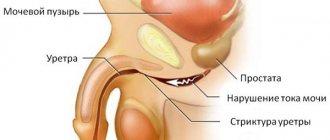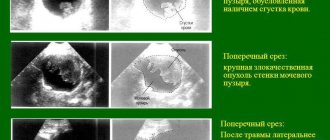What is epispadias
Epispadias is one of the types of developmental anomalies of the organs of the genitourinary system. With this disease, non-closure of the wall of the urethra is noted. Despite the fact that the disease is quite rare, it is diagnosed in most cases in boys than in girls.
- Etiology
- Classification
- Symptoms
- Diagnostics
- Treatment
- Possible complications
- Prevention and prognosis
The causes and pathogenesis of the development of such a disease currently remain unknown, but clinicians suggest that the main factor is either a complicated pregnancy or an unhealthy lifestyle that the expectant mother led while bearing the child.
Symptoms will differ depending on the form of such a developmental anomaly. The main symptoms are considered to be pain during urination, urinary incontinence, and pain during sexual intercourse.
It is possible to make a correct diagnosis already during the initial examination, but to confirm theories, a number of instrumental diagnostic measures are required. Treatment is carried out only by surgery.
Therapy
Epispadias can only be eliminated through surgery. The exception is the capitate form of the pathology, since in this case the functionality of the organ does not suffer and the defect is classified as a cosmetic defect. The following cases are subject to surgical treatment:
- constant involuntary urination,
- strongly pronounced external defects, more often observed in boys,
- the influence of the defect on the psychophysical state.
If epispadias is detected, surgery is not performed immediately. Experts believe that the best age to correct such a defect is from 4 to 6 years. But in practice, such treatment is carried out a little earlier, because the inability to hold urine negatively affects the child’s social development and slows it down. But all surgical manipulations are recommended to be carried out before the boy reaches 10-12 years of age, while there is no erection. Otherwise, it will become more difficult or impossible to maintain reproductive function.
Depending on the type and degree of clefting of the urethra, the goal of the operation is to: restore the integrity of the canal, eliminate the external defect in the curvature of the penis or labia, and form the bladder sphincter.
To restore the anterior wall of the urethra, its edges are sutured and, if necessary, skin flaps are transplanted. To eliminate urinary incontinence, sphincteroplasty is performed.
For girls, plastic surgery of the clitoris or cervix is provided if it is involved in the pathological process. After the operation, regardless of the specifics of the procedure, the bladder is washed and a catheter is installed.
Causes of epispadias
To date, the reasons for the formation of this type of anomaly in the development of the genitourinary system remain unknown. Theories have been put forward that such a pathology occurs against the background of a violation of embryogenesis in the interval between the seventh and fourteenth week of intrauterine development of the fetus.
Nevertheless, clinicians identify a large number of predisposing factors that cause the appearance of this disease:
- a wide range of viral infections that a woman can suffer during pregnancy;
- addiction to bad habits - not all female representatives consider it necessary to give up alcohol, nicotine and drugs just because they will soon become mothers;
- unfavorable environmental conditions;
- early or severe toxicosis;
- prolonged influence of stressful situations and nervous overstrain;
- abdominal injury;
- exposure to ionizing radiation on the body;
- the presence of endocrine disorders in pregnant women;
- the impact on the fetus of harmful effects from the place of work of the expectant mother.
The influence of other factors cannot be excluded.
Brainstem epispadias
This name is usually used to denote epispadias of the penis. With it, the penis is shorter than normal and slightly tucked towards the peritoneum.
The peritoneal muscles also diverge with this pathology; the same applies to the bones that form the pubic symphysis. The pathology causes great inconvenience when urinating, since the discharge is sprayed.
In the absence of proper treatment, the boy will not be able to conceive a child in the future due to the fact that the penis will be deformed in every possible way when an erection occurs.
Classification of the disease
It is worth noting that epispadias is divided into male and female. In addition, absolutely all forms of epispadias can be of two types:
- only with cleft urethra;
- with splitting of the bladder sphincter.
According to the degree of urethral cleft, epispadias in boys is:
- capitate - in this case the urethra is divided up to the coronal groove of the penis;
- stem - in such cases, splitting is observed along the entire length of the penis;
- pubic-trunk - a distinctive feature is that the urethra is split completely, but the sphincter of the bladder is not completely;
- total epispadias - not only the urethra, but also the anterior wall or neck of the bladder has been separated.
A similar deviation occurs in girls:
- clitoral - the clitoris is split into two bodies, separated by a transversely located slit of the urethra. In this case, the clitoris is localized below it;
- subtotal – the child experiences separation of the clitoris and labia;
- total - such parts of the reproductive system as the clitoris, labia, pubic symphysis and bladder sphincter are affected by pathology. The hole in appearance may resemble a wide funnel, from which the membrane of the last organ often protrudes.
In the vast majority, a total or subtotal form of pathology is diagnosed.
Epispadias - total epispadias in boys, treatment, photo of epispadias in children
Epispadias is a congenital abnormality of the urethra, in which part of the urethral wall splits. Apart from problems with the genitourinary system and pelvic bones, other organs, as a rule in such children, do not have any problems with their functioning.
This is why children do not need many diagnostic tests (such as X-rays and CT scans).
If a child is diagnosed with more severe forms, they are at risk for developing other defects, such as enlarged ureters or vesicoureteral reflux.
Depending on the group of epispadias, the severity of the disease and the likelihood of complications are distinguished, so boys with penoplenic epispadias or exstrophy-epispadias have a high risk of being infertile.
In young men without abnormalities in the development of the urethra, the bladder neck closes when sperm move from the testicles into the urethra during ejaculation. In some boys with a developmental defect, the neck of the bladder cannot close completely during ejaculation.
This allows sperm to move backwards into the bladder (retrograde ejaculation), an abnormality that can become a problem when the boy grows up and decides to have children. Some men have low sperm quality due to retrograde ejaculation.
In addition, boys with this syndrome may have problems with sexual intercourse, the fact is that the penis may have a downward or sideways bend, often a slight deviation from the norm - it does not interfere with full sexual intercourse, but a strong bend requires surgical intervention.
Girls with epispadias are not at risk of becoming infertile as adults because their internal organs develop normally.
Symptoms of epispadias
Most cases of epispadias are diagnosed at birth through a physical examination of the newborn. In the early stages of epispadias, the abnormality may go unnoticed until parents notice urine leakage after potty training.
: Cryptococcosis in humans - symptoms, photos, treatment methods
Reasons for the development of epispadias
The formation and development of a child's organs in the womb is a very complex process, and the steps must be followed sequentially. If a failure occurs during the formation of any organ, then most likely there will be other defects during the formation of other organs.
Some boys may have a small dimple at the tip of the penis, while girls may have a double clitoris. So it can be said that if a malfunction occurs during the formation of one of the organs from the child’s genitals, then the entire urinary system suffers, including the sexual function of the organ. This large circle is called the bladder exstrophy complex.
Treatment of epispadias
The main goal of treatment is to restore and improve the functioning of the genitals, while doing so with the least number of operations.
The main goals of treating epispadias for boys are:
- Restoring the functionality of the penis
- Straighten the penis, remove bends
- Make a medium length penis
If the bladder or bladder neck is affected, surgery may be necessary to help the child control his urine. Surgery may also be required to keep the ovaries working.
There are two popular types of surgery. Both ensure the normal shape of the penis and also restore performance.
Surgery options for girls
Surgery for girls is less complicated than for boys. The urethra and vagina may be short and located at the front of the body. The clitoris can be in 2 parts. The internal structure of the uterus, fallopian tubes and ovaries are usually in normal condition.
After operation
With the help of new methods of surgical restoration at birth, almost every third child can restore the functioning of the urethra without other procedures. Girls with exstrophy-epispadias complex often require additional surgery to reconstruct the bladder neck. This is necessary to improve the strength of the urethra and sphincter.
FAQ
Risk of contracting urinary tract infection in children with epidemics
Currently, research does not confirm that epispadias lead to urinary tract infections. But in the case of complete exstrophy-epispadias, the child will be at increased risk than people without developmental anomalies. Vesicoureteral reflux (reflux of urine from the bladder into the ureter) is more common. It is most often treated with prophylactic antibiotics.
When is surgery necessary?
Most surgeons agree that epispadias should be surgically removed/restored as early as possible, this is especially true for boys.
With early treatment, bladder capacity usually increases. A well-developed bladder is important for urine control.
Statistics show that if surgery is done within the first few months of life, the child is more likely to have a normal bladder.
Until recently, treatment for epispadias did not begin until the child was one year old.
Symptoms of epispadias
Epispadias in children has various clinical manifestations, which directly depend on the type of disease. Thus, the capitate type of such a disease can be completely asymptomatic, but only if no splitting of the foreskin area has occurred. In such cases, the main signs are:
- splashing stream of urine, but the act of urination itself is not disturbed;
- slight deformation of the penis. However, erection and other sexual functions remain normal.
Symptoms of the stem form of the birth defect:
- the opening of the urethra is located near the root of the penis;
- significant splashing of urine, causing a boy or man to urinate in a sitting position;
- urinary incontinence - observed in cases of influence of strong physical exertion, intense laughter or coughing;
- pronounced curvature of the penis - its shortening and curvature towards the anterior wall of the abdominal cavity is observed;
- difficulty in having sexual intercourse.
The pubic-trunk type of pathology is expressed in:
- shortening and significant deformation of the organ;
- the location of the urethral opening directly under the pubic symphysis;
- inability to have sexual intercourse;
- urinary incontinence.
Total epispadias has the following symptoms:
- underdevelopment of the penis and its hook-shaped form;
- constant leakage of urine outward - this is due to the fact that the cavernous bodies and the neck of the bladder have undergone splitting;
- complete absence of sexual functions;
- curvature of the pubic bones, which is expressed in a “duck walk”;
- separation of the abdominal muscles, which leads to the formation of a “frog” abdomen.
In addition, approximately every third patient experiences:
- pyelonephritis;
- hydronephrosis;
- hypoplasia of the testicles, prostate or scrotum;
- cryptorchidism;
- Vesicoureteral reflux.
Epispadias in boys photo.
As for this disease in girls, then:
- the clitoral type of the disease does not cause disturbances in the act of urination;
- the subtotal form is expressed in urinary incontinence when sneezing, coughing or during intense exercise;
- The total type is characterized by constant leakage of urine, which causes maceration of the skin in the area of the external genitalia and inner thighs. In addition, it is possible to develop an infectious process in the urinary tract, diaper dermatitis, vulvovaginitis, vaginal duplication, hypoplasia of the clitoris or labia.
Epispadias - what kind of disease is this in children?
People all over the world face problems with the genitourinary system. There are a huge number of diseases in this area. Some of them are acquired, others are congenital. It is the latter that includes such a rare anomaly as epispadias!
Epispadias is a defect in the development of the urethra in children, which is caused by both partial and complete separation of its upper wall. Epispadias is considered an extremely rare pathological intratubal disease of the urethra. The disease is characterized by non-overgrowth in the upper part of the urethra, which results in the formation of an open urinary canal, which can have a different length.
As a rule, the disease does not exist independently; it is diagnosed in combination with some congenital pathologies of the urinary system, such as bladder exstrophy, cryptochromosis, inguinal hernia or epispadias.
Boys, in whom epispadias has more pronounced manifestations than in girls, are more susceptible to this disease. After birth in boys, during an external examination it will not be difficult to identify an anomaly, since the displaced external opening is displaced dorsally and this affects the appearance of the penis. For girls, everything is much more complicated, since it is impossible to identify pathology by external signs.
Classification
There are two groups of epispadias: female and male. The main criterion for the classification of this disease is considered to be the degree of urethral cleft. According to this, epispadias in men occurs:
- capitate - clefting of the urethra, which affects the coronary groove of the genital organ;
- stem – clefting of the entire length of the penis;
- pubo-columnar – complete separation of the urethra valve and partial decomposition of the bladder sphincter;
- complete - absolute splitting of the urethra and partial splitting of the organs of the urinary system.
In girls they observe:
- clitoral epispadias - with this type, the clitoris is split into two parts, between which the urethra valve can be seen;
- subtotal – the clitoris and labia are affected;
- total - all elements of the genitourinary system (clitoris, labia, pubic symphysis, sphincter and bladder) are split.
Typically, epispadias is a broad-based disorder and rarely occurs as a single entity. In 90% of diagnosed cases, the disease has a subtotal and total form.
Since epispadias is a congenital disease, it is generally accepted that its development is caused by:
- genetic predisposition to the disease;
- disturbances in the development of the embryo in the period 7-14 weeks;
- infectious diseases of pregnant women;
- diseases of the endocrine system;
- bad habits.
Unfortunately, the exact causes of epispadias are not known. Before the birth of a child, it is impossible to predict this disease, much less begin its treatment - it all depends on the body of the carrying mother.
Symptoms
The clinical course of the disease directly depends on its form and the gender of the sick person. Thus, the following symptoms of different types of epispadias are distinguished:
- Capitate . Visible splitting of the outer tissues of the penis. Quite often, the skin of the penis covers the unfused parts of the organ, so the disease is difficult to identify immediately. No changes in the urinary system are observed with this type of disease; sexual functions, erection and the shape of the penis are not impaired.
- Stem . This species is characterized by the formation of an opening that runs throughout the penis, from the head to the root. With this form of epispedia, there is no erection, sexual intercourse is impossible, and incontinence occurs.
- Full . Distinct modifications, complete deformation of the penis, it takes on a hook-like shape. During an erection, a man experiences severe pain, and sexual intercourse is impossible. There is a constant leakage of urine as the bladder neck separates. In addition, all these changes affect the musculoskeletal system. The disease leads to diastasis of the pubic bone, resulting in a lame gait. There is a risk of developing hydronephrosis, reflux, cryptorchidism, hypoplasia and pyelonephritis.
- Clitoris . This species has no clinical significance. Women with this disease do not have problems with the genitals. Sometimes involuntary leakage of urine occurs during intense physical exertion, sneezing or coughing.
- Total . This type of disease has pronounced external signs - the labia are completely cleft. Deformation of the muscles of the lower abdomen and genitourinary organs occurs, resulting in incontinence. Sometimes bifurcation of the vagina can be observed.
Diagnosis of the disease
In almost all cases, diagnosing epispadias in a child will not be difficult. It is enough just to conduct a thorough external examination of the genital organs.
An experienced urologist will be able to diagnose the specific type of epispadias without any problems. It all depends on external changes in the genital organs. No additional urine or blood tests will be needed for this.
Doctors often have controversial questions about complete or total epispadias, since in specific types there are changes in the internal organs of the genitourinary system.
In such cases, the following types of diagnostics are performed:
- fluoroscopic examination;
- MRI;
- Ultrasound;
- cystoscopy.
Also, when diagnosing, the patient must describe all the symptoms as accurately as possible. There is a high probability of developing another pathology against which epispadias occurred. In this case, additional studies may be prescribed, such as:
If a diagnosis of epispadias is established, it is necessary to visit several specialists who will confirm or refute the preliminary diagnosis. This is necessary, since the treatment of this pathology is carried out exclusively by surgery. If the diagnosis is incorrect, the consequences may be irreversible.
The most severe forms of this disease must be treated at an early age (2 - 3 years), since the body will develop, grow, and in the future there will be no signs of pathology. Carrying out surgical intervention at an early age makes it possible to completely restore the natural structure of the genitals.
The manipulations carried out at an unconscious age of the child will help to avoid possible psychological trauma.
Of course, after the operation, scars will remain on the skin, which will become less noticeable over time, but in later life, additional procedures may be needed to minimize scars and scars.
If the disease does not cause serious physiological changes in the genital organs, then the operation is performed exclusively in adulthood (13–14 years) and only when the process of urination causes inconvenience caused by a deformed genital organ or the formed genitourinary organ has an unaesthetic appearance.
Methods for forming the urethra depend on the form of the disease and are selected strictly individually. The main goals of epispadias surgery include:
- full correction of modified genitourinary organs (penis or labia), since deformed genitals will become an obstacle to sexual activity;
- complete restoration of the missing part of the urethra;
- normalization of the physiological functions of the genitourinary organs;
- complete reconstruction of the walls of the urethra and bladder.
Surgical treatment has its own characteristics, which depend on the form of the disease and the degree of splitting.
If external changes in the genitourinary organs are insignificant, the operation requires only the instrument itself and the skill of the surgeon.
If we are talking about complete or total epispadias, it is most likely that donor tissue (skin) will be needed, which can be taken from other parts of the body or synthetic material can be healed.
Rehabilitation period
The postoperative period is the most important element in the treatment of the anomaly, during which catheterization and active lavage of the bladder are performed. If this is not done, there is a risk of developing cystitis and urethritis, and fistulas may appear at the site of the manipulations.
To restore physiological functions after surgery, doctors prescribe a course of drug treatment.
To do this, they use drugs such as: Riboxin, Neo Tropin, Z Tropin, Nanotrop, Actigrol, Potassium orotate, Methionine, Methandienone and other steroids aimed at accelerating the synthesis of muscle and soft tissue cells. In some cases, doctors prescribe a course of hormone therapy, which includes taking growth hormone.
In order for all sexual functions to return to normal as quickly as possible, you must adhere to a healthy diet. It is advisable to exclude all fried, fatty, spicy and salty foods, and give up carbonated drinks. It is best to eat foods rich in protein and fiber (greens, vegetables, boiled meat and fish, eggs, cottage cheese).
Physical activity is strictly prohibited in the first month. It is necessary to empty the bladder promptly to avoid pressure inside the urethra. If the operation was performed at an early age, the doctor will give instructions regarding the child’s nutrition.
In 95% of cases, operated patients no longer have any problems, the aesthetic appearance and physiological functions of the genitourinary organs are completely restored. Very rarely, after surgery, boys experience a completely slight curvature of the penis, which can be observed during an erection. This is due to the difficulty of fusion of muscle tissue.
If you do not follow all the rules of rehabilitation, serious complications may arise after surgery, which include:
Conclusion
According to statistical estimates, epispadias is observed in one out of 200 thousand newborns.
This is a rare anomaly that does not pose a threat to the health and life of the child; it is only necessary to identify the disease in time.
Surgical correction at a very early age guarantees excellent functional performance, all systems return to normal, and the person has full control over the process of urination.
Complete restoration of sexual function depends on further correction, which, if necessary, is carried out after the main treatment.
Children who have undergone such operations require constant urological and gynecological examination.
In rare cases, children at an older age are diagnosed with hidden deformations of the genitourinary organs, which do not affect the appearance and physiology.
We recommend other articles on the topic
Diagnostics
Pronounced varieties of such an anomaly are recognized immediately after the baby is born, while less obvious ones are detected only when urinary incontinence is noted in a child older than one year.
The initial examination is as follows:
- conducting a detailed survey of the patient or his parents regarding the severity of symptoms;
- studying the life history of the patient and his parents;
- conducting an objective examination to assess the size of the pathology. This will enable the doctor to decide on the form of the disease and treatment tactics.
An initial inspection can be carried out:
- pediatrician;
- pediatric surgeon;
- pediatric urologist or gynecologist.
Using laboratory examination methods, it is possible to detect the presence of an infection of the genitourinary system.
For a comprehensive assessment of the condition and functioning of the urethra and bladder, it is necessary to conduct instrumental examinations, among which it is worth highlighting:
- Ultrasound of organs such as kidneys and bladder;
- radiography;
- urethrography;
- urography;
- profilometry;
- cystometry;
- electromyography;
- cystography;
Cystography photo.
- Ultrasound of the pelvic organs – for girls;
- Ultrasound of the scrotum area - for boys.
Diagnostic methods
Severe forms of this pathology are recognized immediately after the birth of the child. This refers to total epispadias. When the defect is not clearly expressed, it is determined as the child develops. Its main symptom is urinary incontinence. Capitate and clitoral epispadias can go unnoticed for a long time, since they are not accompanied by characteristic symptoms.
The child is examined by a pediatrician, a pediatric urologist and surgeon, as well as a gynecologist. Diagnosis includes an external examination of the genital organs and determination of the form of pathology. In addition, in order to identify concomitant disorders, the following is prescribed:
- Ultrasound of the kidneys, bladder, scrotum, pelvic organs,
- x-ray of the pubic symphysis,
- excretory urography,
- urethrography,
- cystography.
Treatment of epispadias
Such a congenital defect can only be eliminated surgically. It is worth noting that the capitate form of the disease in boys and the clitoral form in girls do not require any specific treatment tactics.
Indications for surgery may include:
- urinary incontinence;
- cosmetic defects;
- disturbance of the psychophysical state of a small patient.
The best age for surgery is five years.
When treating pathology in boys, the doctor sets himself the solution of several tasks:
- elimination of penile deformation;
- formation of a solid urinary channel;
- restoration of the sphincter.
To achieve such effects, the following is carried out:
- correction of curvature of the genital organ;
- urethroplasty;
- sphincteroplasty.
Treatment of epispadias photo.
In girls, plastic surgery of the clitoris or bladder neck is used.
Regardless of the treatment tactics, the postoperative period should include lavage and catheterization of the bladder.
Epispadias
Epispadias
is a malformation of the urethra, characterized by partial or complete splitting of its upper wall.
Epispadias occurs in boys and girls and, in addition to the anatomical defect, is manifested by disturbances in urination (squirting, urinary incontinence), sexual function (painful erection, difficulty in sexual intercourse), and urinary tract infections.
The set of diagnostic measures for epispadias includes a complete urological examination: ultrasound, excretory urography, cystography, radiography of the symphysis pubis, urodynamic studies. Treatment of epispadias is surgical, depending on the form and severity of the defect.
Epispadias is a congenital anomaly of the urethra, in which there is a cleft (cleft) of the dorsal wall of the urethra at various lengths. In pediatric urology, epispadias occurs much less frequently than hypospadias, approximately 1 case per 50,000 newborns. The ratio of male to female epispadias is 5:1.
In approximately half of the cases, epispadias is combined with other anomalies: exstrophy of the bladder, cryptorchidism, inguinal hernias, exstropho-epispadias complex - a number of malformations of the genitourinary system.
With epispadias, urination and sexual function can be significantly impaired, which requires finding effective ways for its early surgical correction by integrating the efforts of pediatric surgery, gynecology, urology and andrology.
Epispadias
The exact causes of epispadias are unknown. It is assumed that abnormalities in the development of the urethra arise due to disturbances in embryogenesis between 7 and 14 weeks of intrauterine development.
In the case of epispadias, the primary genital tubercle is displaced in the caudal direction, which leads to disruption of the mesodermal plate and subsequent non-closure of the anterior wall of the urethra.
Among the direct factors causing embryonic disorders are:
- viral infections of a pregnant woman;
- bad habits, early toxicosis;
- endocrine disorders;
- exposure to occupational hazards on the fetus.
With epispadias, the meatus has the shape of a groove located on the dorsal surface of the penis (with hypospadias - on the ventral, posterior surface) between the underdeveloped, split, cavernous bodies. In female epispadias, there is clefting of the clitoris.
First of all, a distinction is made between male and female epispadias. In addition, all forms of epispadias in men and women are divided into 2 groups: with isolated urethral cleft and with cleft of the bladder sphincter.
The classification of clinical forms of epispadias is based on the criterion of the degree of urethral cleft. In accordance with this, boys are distinguished:
- capitate epispadias - the urethra is cleft to the coronal sulcus of the penis
- stem epispadias – the urethra is split along the entire length of the shaft of the penis
- pubo-trunk epispadias - the entire urethra and part of the bladder sphincter are split.
- total epispadias - the urethra, neck and anterior wall of the bladder are split.
In girls it is customary to distinguish:
- clitoral epispadias - splitting of the clitoris into two bodies, separated by a transverse slit of the external opening of the urethra
- subtotal (subsymphyseal) epispadias – clefting of the clitoris and labia
- total (retrosymphyseal) epispadias – clefting of the clitoris, labia, pubic symphysis, bladder sphincter.
In approximately 90% of cases, subtotal and total forms of epispadias occur.
The clinical picture of epispadias is determined by its shape. Thus, capitate epispadias in the absence of clefting of the foreskin may remain unrecognized.
In this case, urination is not disturbed or is accompanied by a slight splashing of the urine stream.
In more severe cases, there may be a slight curvature of the penis, but erection and sexual function are not impaired in capitate epispadias.
With truncal epispadias, the external opening of the urethra is located near the root of the penis. Voluntary regulation of urination is preserved, however, due to splashing of urine, patients are forced to urinate while sitting.
With stress (laughter, coughing, physical effort), urinary incontinence may occur. There is a pronounced deformation of the penis: its shortening and pulling towards the anterior abdominal wall due to the divergence of the legs of the cavernous bodies.
Sexual intercourse is difficult, but in most cases possible.
Pubic-trunk epispadias is accompanied by pronounced shortening and deformation of the penis, making sexual intercourse impossible. The external opening of the urethra is located under the pubic symphysis; due to partial splitting of the sphincter of the urethra, urinary incontinence occurs, expressed to varying degrees.
With the full form of epispadias, pronounced underdevelopment and hook-shaped deformation of the penis are noted. Erections are painful, sexual intercourse is impossible. There is a splitting of the cavernous bodies and the neck of the bladder, and constant leakage of urine out.
Diastasis of the pubic bones leads to the formation of a “duck gait”, and the divergence of the muscles of the anterior abdominal wall leads to a “frog” abdomen.
In a third of patients, megaureter, vesicoureteral reflux, hydronephrosis, cryptorchidism, testicular, scrotal and prostate hypoplasia, and pyelonephritis are detected.
Epispadias in girls
Clitoral epispadias does not lead to urination problems and has no clinical significance. Subsymphyseal epispadias is accompanied by urinary incontinence when sneezing, coughing, or physical stress.
With total epispadias in girls, there is complete clefting of the labia and pubic symphysis, divergence of the rectus abdominis muscles, which is accompanied by constant leakage of urine, maceration of the skin of the external genitalia and inner thighs, recurrent diaper dermatitis, vulvovaginitis and urinary tract infections. Epispadias in girls can be combined with hypoplasia of the clitoris and labia minora, and vaginal duplication.
Capitate epispadias in boys and clitoral epispadias in girls usually do not require treatment.
The main indications for surgical treatment of epispadias are functional (urinary incontinence) and cosmetic defects that impair the psychophysical development of the child.
The optimal age for surgical correction of epispadias in children is 4-6 years of age (according to some authors, 2-4 years).
In case of male epispadias, the main goals of treatment are the elimination of deformation of the penis, the formation of a complete urethra and the restoration of the bladder sphincter. In connection with the identified tasks, the main stages of surgical intervention include:
The choice of a specific technique (Cantwell, Mitchell, Ransley, etc.) is determined by the individual clinical situation. In girls with clinically significant epispadias, clitoral plastic surgery is performed, and, if indicated, bladder neck plastic surgery is performed.
In the postoperative period, long-term catheterization and lavage of the bladder are performed. Complications of surgical correction of epispadias may include fistulas of the bladder and urethra, urethral strictures, urinary incontinence, and narrowing of the vagina. In the future, men may maintain penile curvature, develop erectile dysfunction, and infertility.
Early surgical correction of epispadias in most cases allows one to achieve good functional results, develop voluntary control over urination, and prevent the development of psychological disorders. The prognosis for sexual function and fertility largely depends on associated developmental abnormalities and their correction.
Children who have undergone surgical correction of epispadias at an early age require constant monitoring by a pediatric urologist. In some cases, in adolescence, hidden deformations of the penis are revealed.
Source: https://www.KrasotaiMedicina.ru/diseases/children/epispadias
Prevention and prognosis
Since the reasons for the development of such an anomaly remain unknown, there are no specific preventive measures. However, female representatives during pregnancy need to:
- completely give up bad habits;
- eat properly and balanced;
- avoid stress if possible;
- take precautions, and it is best to completely refuse work that involves occupational hazards;
- seek qualified help in cases of the slightest change in health status.
Thanks to the possibility of early detection and surgery, it is often possible to achieve a favorable prognosis, which consists of restoring and controlling urination, as well as preventing psychological disorders.
It is worth noting that those patients who underwent surgery to eliminate epispadias in childhood should be constantly monitored by a urologist (for males) or a gynecologist (for females).
Prevention
Recommendations for the prevention of developmental anomalies can only be general. They are known to any expectant mother, which does not prevent many from not doing them.
- Infections are very dangerous for a pregnant woman. Moreover, the danger comes both from the pathogen itself and from the drug used for treatment. The expectant mother should monitor her health very carefully.
- It is necessary to give up bad habits - alcohol, drugs, smoking, at least during pregnancy and lactation.
- You can't give up physical activity. This not only promotes good health, but also facilitates the course of toxicosis, and the latter is one of the possible causes of the pathology.
- If the expectant mother's work involves toxic production or involves ionizing radiation, it is necessary to refuse it. The risk of pathological development of the fetus is very high.
Epispadias is a severe developmental defect that leads to disruption of normal urination, and in men, also to disturbances in reproductive function. The pathology can only be cured surgically and does not require therapeutic treatment.
Causes of pathology
Since epispadias is a congenital disease, it is generally accepted that its development is caused by:
- genetic predisposition to the disease;
- disturbances in the development of the embryo in the period 7-14 weeks;
- infectious diseases of pregnant women;
- diseases of the endocrine system;
- bad habits.
Unfortunately, the exact causes of epispadias are not known. Before the birth of a child, it is impossible to predict this disease, much less begin its treatment - it all depends on the body of the carrying mother.









